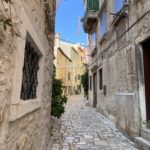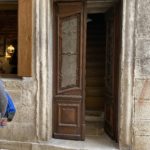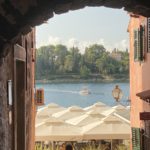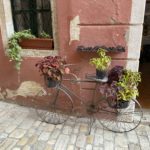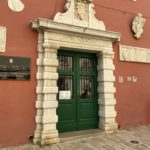We explored one of the most beautiful regions of western Croatia on a full-day tour of the Istrian Peninsula. As we drove into the countryside, we drove through. Grey Istria, called that because of all the limestone, transitioned into green Istria with its oak trees and fertile hunting grounds for truffles, both black and white. Then we entered into red Istria with its characteristic red soil.
On the way, Stefan entertained us with Yugo jokes. Yugos were produced in Yugoslavia during the 70’s and 80’s and had the reputation of being the worst automobile in the world – BUT they were cheap and spare parts were plentiful – even available in grocery stores. They never evolved or changed, stayed the same throughout its production. One of Stefan’s jokes was what is the most useful and important page in the Yugo user manual? Answer: The Bus Schedule!, or whenever you go, it doesn’t! How about what do you call a Yugo on top of the hill? Answer: A miracle! Why is the rear window in a Yugo heated? Answer, so you warm your hands when you push it. We even saw a red Yugo in a traffic circle on the way.
Discussion shifted to the latest technology under current development to the fastest car in the world. Developed by a young man here in Croatia, the electric concept model by Rimac is expected to cost about $2M. It is so trendsetting Bugatti and Porsche have invested in the company. Rimac will focus on development of new technologies in electric cars, batteries, etc.
Our tour also took us to the picturesque coastal town of Rovinj, which was part of Venice’s mercantile empire and has a distinctive Venetian aspect to it. We met our guide, Nada, who walked us through the street market, and through the port. For the best views of the town and the harbor, she took us on a mile-and-a-quarter trek uphill to St. Eufemia church it was well worth the effort! St. Eufemia was brutally martyred for her faith. When the lions were released to finish her off, they calmly approached her and gently licked her feet. Her remains were placed in a stone sarcophagus to be sent to Venice, but the ship sank and the sarcophagus floated to shore. Because the sarcophagus was so heavy, the townspeople of Rovinj were unable to pull it up the hill. However, a young 14 year old boy with faith was able to single-handedly pull it up the hill. Or so the legend goes. The saint’s remains and the sarcophagus are kept in the apse.
Rovinj was originally an island port built by Romans. In 1763 it was joined to the coastline by filling in the channel. Initially ruled by Byzantines and Franks, it fell under Venetian control from 1283 To 1797. In fact, the tower of the St Eufemia Church, modeled after that of San Marco in Venice, was a communication avenue to Venice, sort of like “one if by land; two if by sea of Paul Revere fame.
After bit of free time exploring the town, we walked around the harbor, to Kantinon, a local restaurant, where started our lunch with a plate of cheese and meat with a fig chutney, accompanied by bread and olive oil, followed by Bugatti pasta (more like a dense dumpling) in a black truffle sauce with a local white wine. Dessert was cheesecake.
Then back on the bus to explore Pula Arena, Europe’s most complete Roman amphitheater. In Roman times, Pula was a colony known as Pietas Julia. In the 6th and 7th centuries, it became the main base for the Byzantine fleet. Over time, by the mid 17th century, the population declined to only 300 people. It was revitalized in 1856, when Austria based its fleet there. Today it is a bustling coastal city.
But our focus here in Pula was the amphiteatre, its most iconic landmark. It is the sixth largest surviving Roman arena and the only one to have all four side towers. The towers had cisterns of scented water that was sprayed onto the stalls. Spectators were shielded from the sun by awnings. Once the sandy floor absorbed the remains of bloody combat; today it is a music and film venue – and site for photo shoots as we found. Built by Claudius and enlarged by Vespasian in 79AD, it was intact until the 15th century when some of the stone was used in other buildings. We descended the uneven stone stairs (a means of crowd control) beneath the arena floor to see the passageways and rooms where gladiators and their foes, including wild animals, awaited their turn in combat. Artifacts from around the city are now stored in the passageways and the cages are gone.
We arrived back at the hotel a little after 5 pm. We strolled the longamore, the 7.5 mile seaside pathway to the seaside fishing village of Volosko, where we had dinner at Plavi podrum, a highly recommended seafood restaurant. We were told by several people that it would be a 20 or 30 minute walk; but it took us 50 minutes.
Sezze Plavi podrum (Blue Basement) is the only Croatian restaurant that was ncluded twice in the San Pellegrino list of the 100 best restaurants in the whole world. It is located in the harbor of Volosko, locally called the mandraÄ, next to the sea, which has influenced the menu, offering primarily fish dishes prepared in a unique way. Over 100 years old, this place surprises with a contemporary approach to gastronomy, inspired by traditional dishes and fresh ingredients of the region, primarily freshly caught fish and shrimps. Plavi podrum is also known for its exceptional wine list. Grilled Calamari was my choice along with a Croatian white wine. Our waiter treated us with a glass of mistletoe brandy as an after dinner digestive.









